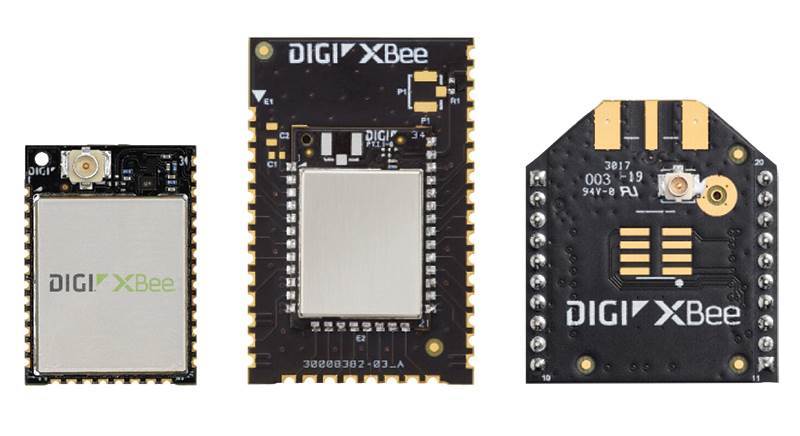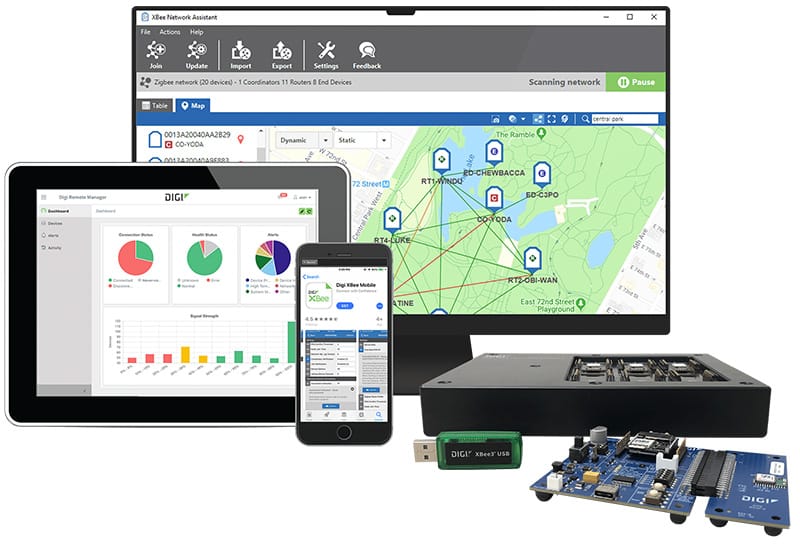What Is Wi-SUN?
Wi-SUN® (Wireless Smart Ubiquitous Network) is a standardized wireless mesh networking protocol designed for large-scale outdoor IoT applications such as smart city and smart utility use cases. Wi-SUN is the leading IPv6 sub-GHz mesh technology, acting as a wireless communication standard to facilitate seamless connectivity among smart-grid devices. Built on the IEEE 802.15.4g standard, Wi-SUN enables interoperable, multi-service networks that connect millions of devices across smart cities, utilities, and industrial applications with exceptional reliability and scalability.
Digi's Complete Solution for Wi-SUN
Digi offers a complete solution for Wi-SUN® — an industry first, designed to simplify and expedite deployment, while enabling critical remote visibility and management of your network.
Digi's solution for Wi-SUN includes:
- Digi XBee modules for Wi-SUN, designed to integrate seamlessly with existing infrastructure and provide robust Wi-SUN mesh network connectivity
- Digi XBee Hive Gateway and border router for Wi-SUN, certified for global deployment, with highly flexible configurations for a wide range of use cases
- Digi Remote Manager® — a full-featured, cloud-based platform that enables you to manage your deployment from anywhere, including performing mass firmware updates
- Digi XBee Tools — a suite of software and hardware tools for prototyping, building, deploying and managing your devices and network, including Digi XBee Studio for configuration and testing, and the Digi XBee Mobile App
 Deploy
Deploy
The History of Wi-SUN
Wi-SUN technology emerged from the need for reliable, large-scale wireless networking solutions for smart infrastructure. Founded in 2011, the Wi-SUN Alliance® is comprised of over 300 members that are helping to bring the ubiquitous and interoperable Wi-SUN protocol to global markets. The protocol has evolved from early smart grid requirements into a comprehensive wireless standard supporting diverse IoT applications across multiple industries and geographic regions.
The Role of Wi-SUN in IoT
Wi-SUN can be used for large-scale outdoor IoT wireless communication networks in a wide range of applications. The protocol offers a standards-based, field-proven mesh networking protocol supporting interoperability between devices and vendors, and enabling seamless device-to-device communication and data aggregation. Wi-SUN networks support both line-powered and battery-operated devices, making them ideal for comprehensive IoT deployments.

What Is the Wi-SUN Alliance?
The Wi-SUN Alliance® seeks to advance seamless connectivity by promoting IEEE 802.15.4g standard-based interoperability for global regional markets and emerging economies. This international consortium drives Wi-SUN standardization, certification, and adoption worldwide through comprehensive industry collaboration. The Alliance ensures interoperability between vendors, promotes best practices, and develops detailed specifications that enable massive-scale deployments across diverse markets and applications.
The Wi-SUN Protocol
The Wi-SUN protocol represents a sophisticated mesh networking methodology built on proven international standards and industry best practices. At its core, Wi-SUN utilizes IPv6 addressing and RPL (Routing Protocol for Low-power and Lossy Networks) to create self-healing, adaptive networks with dynamic topology management. The protocol operates in sub-GHz frequency bands, providing excellent propagation characteristics for challenging outdoor applications and harsh environments.
Wi-SUN networks automatically discover neighboring devices, establish optimal routing paths, and maintain network integrity even when individual nodes fail or are added. The protocol employs frequency hopping spread spectrum (FHSS) techniques, supporting both OFDM and FSK modulation modes to mitigate interference and ensure robust performance across varied network environments. Advanced security features protect data transmission and device authentication throughout the network infrastructure. Wi-SUN also incorporates sophisticated power management capabilities, enabling battery-powered devices to operate for years without replacement or maintenance. The protocol's standardized approach ensures that devices from different manufacturers can interoperate seamlessly, creating vendor-neutral network ecosystems.
Advantages of the Wi-SUN Protocol
The Wi-SUN FAN (Field Area Network) protocol introduces significant enhancements that address evolving IoT connectivity requirements across diverse industry sectors and deployment scenarios worldwide. These enhancements deliver improved performance, expanded functionality, and enhanced security features through advanced engineering innovations and comprehensive testing protocols developed by industry experts.
These improvements make Wi-SUN networks more robust, reliable, and versatile than ever before, supporting next-generation smart infrastructure applications with unprecedented scalability and efficiency. The enhanced protocol architecture enables seamless integration with existing systems while future-proofing investments.
Key features and benefits of Wi-SUN:
- Mesh networking ensures resilient, self-healing communication for critical infrastructure deployments
- Supports large-scale, outdoor IoT networks with long-range, low-power wireless connectivity
- Offers interoperability across vendors, enabling flexible and future-proof device integration
- Provides built-in security with certificate-based authentication to protect network and data integrity
- Low latency communication supports real-time applications like smart grid monitoring
- With Wi-SUN, FSK ensures long-range coverage, exceptional receiver sensitivity, and energy efficiency, while OFDM unlocks faster data rates, optimized spectrum performance, and reliable operation even in challenging environments.
- Scalable architecture easily accommodates thousands of connected devices
- Operates in sub-GHz bands for better penetration and extended coverage
- Open standards-based design promotes ecosystem growth and vendor collaboration
Wi-SUN Wireless Security
Wi-SUN incorporates a layered security model providing both device-level and network-level protections. Key elements include mutual authentication using X.509 digital certificates, which ensure that only trusted devices can join the network. This process is handled through Public Key Infrastructure (PKI), preventing rogue devices from accessing sensitive data or services.
A standout feature of Wi-SUN security is its support for secure bootstrapping and key management at scale, essential for deployments involving thousands of endpoints like smart meters, streetlights, or sensors. The protocol ensures secure over-the-air (OTA) firmware updates and employs per-hop and end-to-end encryption to protect data as it travels across the mesh network. Integrity and replay protection mechanisms, such as message counters and cryptographic message authentication codes (MACs), help guard against common attacks like spoofing or data tampering. These comprehensive features make Wi-SUN a highly secure choice for critical infrastructure applications, balancing strong security with the operational flexibility required in dynamic, outdoor environments.
Power Efficiency
Wi-SUN is designed to optimize power consumption through intelligent duty cycling and efficient communication protocols that minimize active transmission periods. Battery-powered devices can operate for multiple years on a single charge, making Wi-SUN ideal for remote monitoring and sensing applications where power access is limited. The protocol incorporates advanced sleep modes, adaptive transmission scheduling, and energy-aware routing algorithms that dynamically adjust based on network conditions and device requirements. Smart power management features include synchronized wake-up schedules and data aggregation techniques to support energy-efficient operation across extended deployment periods.
Device Longevity
Wi-SUN networks support devices with operational lifespans exceeding 10 years through hardened components and resilient communication architectures. The protocol's robust design and minimal maintenance requirements ensure long-term reliability, reducing total cost of ownership for large-scale deployments across diverse environmental conditions.
Advanced error correction mechanisms, self-diagnostic capabilities, and automated recovery procedures help maintain device functionality throughout extended operational periods. The protocol's ability to adapt to changing network topologies, handle component degradation gracefully, and support remote firmware updates ensures deployed devices continue operating reliably without requiring frequent physical maintenance or replacement interventions.
Scalability
When paired with a remote configuration, monitoring and management platform like Digi Remote Manager, Wi-SUN networks can scale from small pilot projects to massive city-wide deployments with thousands of connected devices across multiple square kilometers. The protocol's hierarchical architecture and efficient routing algorithms maintain performance as networks grow, supporting incremental expansion without compromising network integrity. Advanced mesh topology management enables seamless addition of new nodes while automatically optimizing data paths and load distribution across the network infrastructure.
The protocol's distributed processing capabilities, dynamic bandwidth allocation, and intelligent congestion control mechanisms ensure consistent performance even as device density increases significantly. Scalable security frameworks and centralized management tools provide network operators with comprehensive visibility and control over large-scale deployments without causing additional administrative overhead.
Common Wireless Applications for Wi-SUN
Wi-SUN technology addresses diverse connectivity challenges across multiple industries and applications. The protocol's versatility and reliability make it suitable for mission-critical deployments that require consistent, long-term performance.
- Smart utilities: Advanced metering infrastructure, distribution automation, and grid monitoring systems
- Smart cities: Street lighting control, traffic management, environmental monitoring, and public safety systems
- Industrial IoT: Asset monitoring, predictive maintenance, process monitoring, and facility management applications
- Smart agriculture: Tank monitoring, irrigation control, barn and greenhouse monitoring, and crop management systems
- Environmental monitoring: Air quality sensors, weather stations, water quality monitoring, and pollution tracking
Examples of Wi-SUN Devices
Wi-SUN technology enables connectivity for diverse device types across multiple application domains. These devices leverage the protocol's reliability and scalability to deliver consistent performance in challenging deployment environments.
- Smart meters: Advanced utility meters that automatically report consumption data and support remote disconnect capabilities for electricity, gas, and water services
- Street light controllers: Intelligent lighting systems that adjust brightness based on ambient conditions and occupancy while reporting operational status
- Environmental sensors: Weather monitoring stations that collect temperature, humidity, air quality, and precipitation data for urban planning
- Traffic management systems: Connected traffic lights and monitoring devices that optimize traffic flow and reduce congestion
- Industrial sensors: Process monitoring equipment that tracks temperature, pressure, vibration, and other parameters for predictive maintenance
- Agricultural monitors: Soil moisture sensors, and irrigation controllers that optimize crop yields and resource utilization
- Security devices: Perimeter monitoring systems, access control points, and surveillance equipment for facility protection
Wi-SUN Wireless Network Topology
Wi-SUN networks support multiple topology configurations to accommodate diverse deployment requirements and environmental constraints. The protocol's flexible architecture enables optimal network design for specific applications.
Mesh Topology
Mesh networks provide the highest level of redundancy and reliability by enabling multiple communication paths between devices. Each node can communicate with multiple neighbors, creating self-healing networks that automatically route around failed devices. This topology is ideal for large-scale deployments where network reliability is critical, such as smart utility applications and city-wide monitoring systems.
Star Topology
Star configurations connect multiple endpoint devices to a central hub or gateway. This topology simplifies network management and reduces complexity for applications with moderate scale requirements. Star networks are well-suited for building automation, industrial monitoring, and campus-wide sensor deployments where centralized control is preferred.
Tree Topology
Tree networks organize devices in hierarchical structures with clear parent-child relationships. This topology optimizes data aggregation and reduces network traffic by consolidating information at intermediate nodes. Tree configurations work well for applications requiring structured data collection, such as environmental monitoring and asset tracking systems
Hybrid Topology
A hybrid Wi-SUN topology combines elements of both mesh and star network structures to provide a flexible, scalable, and robust communication architecture for smart grid and industrial IoT applications. In this topology, end devices such as smart meters or sensors can communicate either directly with a central collector (as in a star topology) or indirectly through neighboring nodes via multi-hop routing (as in a mesh topology). The hybrid approach leverages the resilience and self-healing benefits of mesh networking — where data can take multiple paths to reach its destination — while allowing for direct, low-latency communication where possible. This dynamic structure enables efficient energy use, enhanced coverage in complex environments, and improved network reliability, especially in large-scale deployments across urban and rural areas.
Wi-SUN Specifications
Wi-SUN technology encompasses multiple specification versions that address varying application requirements and deployment scenarios. These specifications ensure interoperability while providing flexibility for diverse use cases across residential, industrial, and utility sectors.
Wi-SUN FAN 1.1
Wi-SUN FAN (Field Area Network) represents the most comprehensive specification for wide-area wireless mesh networks supporting million-scale device deployments across wide geographical areas. FAN networks support thousands of devices across extensive geographic areas, making them ideal for utility and smart city applications.
The specification defines protocols for device discovery, network formation, routing, and security management. Wi-SUN FAN networks operate in sub-GHz frequency bands to provide excellent propagation characteristics and minimize interference. The specification includes provisions for both line-powered and battery-operated devices, supporting diverse deployment scenarios and application requirements. FAN 1.1 provides self-forming, self-healing IPv6 connectivity to deliver seamless network performance with advanced mesh architecture capabilities.
Comparison of Wi-SUN Data Rates and Latencies
| IoT Network |
Data rate |
Latency |
| LTE Cat 1 |
Up to 10 Mb/s |
~50–100 ms |
| LTE Cat 4 |
Up to 150 Mb/s |
~30–50 ms |
| LTE-M |
Up to 1 Mb/s |
~10–15 ms |
| NB-IoT |
Up to 140 kb/s uplink / 80 kb/s downlink |
2–10 s |
| IEEE 802.15.4 |
250 kb/s @ 2.4 GHz; 20–40 kb/s @ 868/915 MHz |
~1–50 ms one hop |
| Bluetooth (LE) |
1 Mb/s (LE 1M), 2 Mb/s (LE 2M), and 500/125 kb/s (LE Coded) |
~7.5–50 ms |
| DigiMesh® |
10 kb/s–250 kb/s |
5–63 ms |
| Wi-Fi (typical IoT: 802.11n, 1x1) |
72.2–150 Mb/s |
~1–30 ms |
| Zigbee mesh |
250 kb/s |
Single hop ~10–20 ms; multi hop < 200 ms |
| Wi-SUN® FAN 1.1 |
Up to 2.4 Mb/s |
0.01–1 s |
| LoRaWAN |
300 bit/s–62.5 kb/s (depending on spreading factor) |
1–16 s |
Explore the Complete Digi Wi-SUN Solution
Digi’s end-to-end solution for Wi-SUN offers everything OEMs and integrators need to build, deploy and manage a complete, long-range wireless mesh network for smart city and industrial IoT applications. At the solution’s core are XBee for Wi-SUN modules, enabling secure, standards-based sub-GHz communication. These modules connect seamlessly to the XBee Hive Border Router, which aggregates and routes traffic to IP-based networks. Digi Remote Manager provides centralized management and monitoring, enabling secure device configuration, firmware updates, and network diagnostics at scale. The combined solution supports reliable, scalable, and manageable connectivity for distributed sensor networks, including street lighting, utility meters, and other critical infrastructure applications across large geographic areas with minimal power consumption.
 |
|
 |
Coming Soon
Digi XBee Hive Gateway and Border Router for Wi-SUN
|
 |
|
 |
|
 |
|
Digi Wireless Design Services
Need design and build support for your next project? Digi Wireless Design Services can help. This expert team of creative engineers offers the full range of engineering support to set your project up for success, including security integration, configuration and testing, and even ongoing monitoring and support services.
Wi-SUN Technology FAQs
Which Frequencies Does Wi-SUN Operate On?
Wi SUN runs in regional license exempt sub GHz ISM bands, most commonly:
- North America: 902 to 928 MHz
- European Union: 863 to 870 MHz
- Japan: 920 to 928.1 MHz
- India: 865 to 868 MHz
These frequency allocations provide excellent propagation characteristics for outdoor applications while minimizing interference from other wireless technologies. The specific frequency selection depends on local regulatory requirements and application needs.
What Is the Range of Wi-SUN?
Wi-SUN networks can achieve communication ranges of several kilometers per hop in outdoor environments, depending on antenna design, transmit power, and terrain characteristics. In urban environments, typical ranges are 1-2 kilometers, while rural deployments may achieve 5-10 kilometers between nodes. The mesh network topology extends total coverage by allowing multi-hop communication paths that can span hundreds of square kilometers. Network range depends on factors including frequency band, power output, antenna configuration, and environmental conditions.
What Is a Wi-SUN Border Router?
A Wi-SUN border router serves as the central coordination point for network operations and typically provides backhaul connectivity to enterprise networks or cloud services. The border router manages network formation, security key distribution, and routing optimization. It acts as both a gateway and cellular router that bridges the Wi-SUN network with traditional IP networks. Border routers may also provide network monitoring, device management, and diagnostic capabilities for network operators.
How Does Wi-SUN Work?
Wi-SUN networks operate by creating self-organizing mesh topologies where devices automatically discover neighbors and establish optimal communication paths. The protocol uses frequency hopping spread spectrum and OFDM modulation techniques to minimize interference and maximize reliability. Devices periodically broadcast advertisements to maintain network connectivity and adapt to changing conditions. The network automatically routes data through the most efficient paths, providing redundancy and self-healing capabilities when devices fail or are added to the network.
What Is the Difference Between Wi-SUN, Zigbee, and DigiMesh?
Wi SUN, Zigbee mesh, and DigiMesh differ mainly in stack design, bands, and ecosystem. Wi SUN is a field area mesh with frequency hopping over low-power networks, aiming at large outdoor deployments (utilities, smart city) with multi-vendor certification and long range sub-GHz links.
Zigbee builds its own network/application layers most commonly at 2.4 GHz, using mesh routing. It unifies profiles for broad device interoperability, making it common in home/building automation but not IP based at the mesh layer.
DigiMesh is Digi’s XBee centric peer-to-peer mesh protocol available in 2.4 GHz and sub-GHz. All nodes are peers/routers and can participate in synchronized “sleeping router” operation, enabling fully battery powered meshes for simplicity and long life.
How Do I Create a Wi-SUN Mesh Network?
Creating a Wi-SUN mesh network involves several key steps, including performing a site survey, provisioning Wi-SUN capable devices throughout the coverage area, and installing Wi-SUN border routers to provide network coordination and backhaul connectivity.
Digi simplifies this process by delivering a complete Wi-SUN deployment solution, including Digi XBee for Wi-SUN wireless modules, Wi-SUN border routers, Digi Remote Manager for configuration and remote management, and Digi XBee Tools for local provisioning. Contact us for assistance.